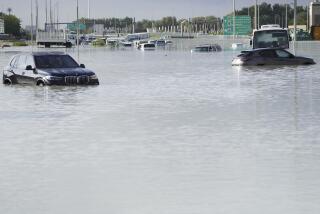Yeonpyeong Island a Korean peninsula hot spot
This week’s North Korean artillery attack wasn’t the first time isolated Yeonpyeong Island has been center stage in the Korean peninsula’s military standoff.
Just three miles across — part military outpost, part civilian fishing village — Yeonpyeong is the closest South Korean island to North Korea, a few nautical miles from the barricaded shores of Kim Jong Il’s secretive regime.
For half a century, the two sides have skirmished repeatedly over the archipelago, a tug of war that includes everything from sovereignty to the local catch of blue crab prized by both sides. In 1999 and 2002, the rivals’ navies clashed near Yeonpyeong, resulting in numerous casualties.
This time, North Korea fired scores of artillery shells onto the disputed island, killing two marines and two construction workers and injuring 20 military personnel and civilians.
Nearly half of the 170 North Korean shells reportedly struck the island. The explosives burned about two dozen homes and damaged military installations, causing 700 people to be evacuated to the mainland.
Photos from the island taken Thursday show survivors wading through streets filled with wreckage as evacuees began to recount the bombardment.
“I was in a shelter when the second round of attacks came and artillery sounds shook the entire place,” one 54-year-old woman told Seoul’s Yonhap news service.
The bone of contention is the so-called Northern Limit Line, an invisible boundary established by the United Nations at the cessation of the Korean War.
But North Korea has long rejected that decision, claiming that the maritime border is farther south. Yeonpyeong Island, Pyongyang insists, is part of its territory. A newscaster in North Korea this week again made that point, calling the attack a tactic to protect its island from the south.
“The island is a hot spot; both sides claim it,” said Donald Gregg, a former U.S. ambassador to Seoul in the George W. Bush administration. “That whole area of the western sea boundary has been very difficult. It’s a tough stretch of water, and Yeonpyeong sits right in the middle of it.”
Yeonpyeong lies 70 miles west of the South Korean coastal city of Incheon, where Gen. Douglas MacArthur landed in 1950. Today, the island is equipped for crab fishing and for war. About 1,700 civilians make their homes there, mostly fishermen, as well as a full-time garrison of 1,000 marines.
Pockmarked by tank traps and trenches, Yeonpyeong has more than a dozen fully stocked bomb shelters where residents conduct monthly air raid drills, officials say. According to one 2009 Seoul media report, “The small village on the island appears almost built into the base, and even civilians were seen strolling along the rugged hillside roads below which soldiers exercised next to their barracks.”
Trucks loaded with armed soldiers constantly move through the village, the report added. To protect its claim, the South Korean military has posted one of its newest classes of guided-missile ships, designed for close-range battles, near the island.
“The island has been a base for Korean marines since the Korean War,” said Joseph Bermudez, leading analyst of the North Korean military for Jane’s Intelligence Review. “Besides military, it is mostly fishermen and their families — I believe there are some descendents, the original prewar fishermen.”
In recent years, North Korea has often shown its displeasure with Seoul and Washington by directing rocket attacks at Yeonpyeong. This June, Pyongyang responded to joint U.S.-South Korean military drills by firing 130 artillery shells toward Yeonpyeong, none of which hit the island.
Yeonpyeong has seen bloodshed. In 1999, 30 sailors from the North and South died as the two sides exchanged gunfire on the water near the island over two successive days.
In 2002, more than a dozen sailors died as gunboats traded fire near Yeonpyeong. The guns fired by the North Korean ships were loud enough to rattle the windows of residents there.
The North’s most recent artillery barrage has left nearly 70% of forests and fields on the rural island destroyed by a wildfire sparked by the attack.
Analysts aren’t surprised the Yeonpyeong Island powder keg exploded again.
“The U.S. and South Korea have conducted large-scale operations in the area that have angered North Korea,” Gregg said. “All the while, we’ve gotten used to Pyongyang saying, ‘If you do this, we’ll retaliate.’ Well, this time, they did.”
Kim works in The Times’ Seoul Bureau. Times staff writer Barbara Demick in Beijing contributed to this report.
More to Read
Start your day right
Sign up for Essential California for news, features and recommendations from the L.A. Times and beyond in your inbox six days a week.
You may occasionally receive promotional content from the Los Angeles Times.







